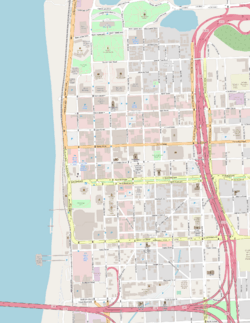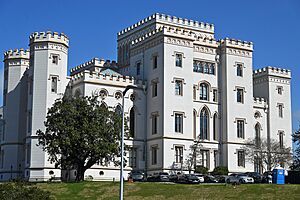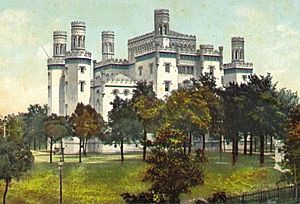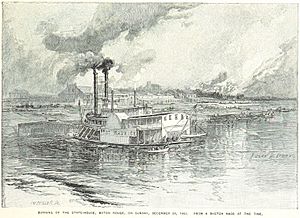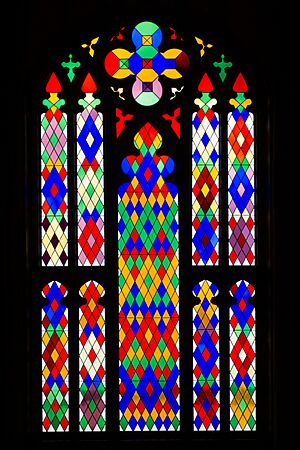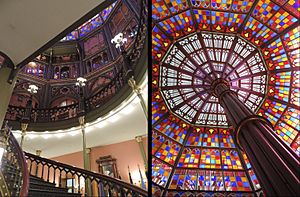Old Louisiana State Capitol facts for kids
|
Old Louisiana State Capitol
|
|
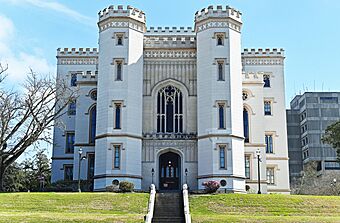
Old Louisiana State Capitol
|
|
| Location | 100 North Boulevard, Baton Rouge, Louisiana, United States |
|---|---|
| Area | 4.6 acres (1.9 ha) |
| Built | 1847–1852 |
| Architect | Dakin, James H.; Freret, William A. |
| Architectural style | Gothic Revival |
| NRHP reference No. | 73000862 |
Quick facts for kids Significant dates |
|
| Added to NRHP | January 12, 1973 |
| Designated NHL | May 30, 1974 |
The Old Louisiana State Capitol is a famous historic building in Baton Rouge, Louisiana. It looks like a castle and is sometimes called the "Louisiana Castle" or "Castle on the River." For many years, it was where the state's lawmakers met.
This building served as the home for the Louisiana State Legislature from the mid-1800s until a new, taller capitol building was finished in 1932. Today, it is a museum called the Museum of Political History. It helps people learn about Louisiana's past.
The Old Louisiana State Capitol is very important. It was added to the National Register of Historic Places in 1973. It was also named a National Historic Landmark in 1974. This means it is recognized as a special place in American history.
Contents
A Look Back: The Capitol's Story
Why the Capital Moved
In 1846, the state government decided to move the capital city. It had been in New Orleans, which was a very large city. Lawmakers from other parts of Louisiana worried that New Orleans had too much power. Baton Rouge was a much smaller town at the time.
So, the state legislature chose Baton Rouge as the new capital. This helped to spread power more evenly across the state.
Building a Castle on the Bluff
On September 21, 1847, the city of Baton Rouge gave the state land for the new capitol building. This land was on a high bluff overlooking the Mississippi River. Some people believe this spot was once marked by a "red stick," or baton rouge, used by Native Americans for meetings.
A New York architect named James H. Dakin was chosen to design the building. Instead of making it look like the U.S. Capitol in Washington, D.C., he designed a unique castle. It was built in the Gothic Revival style, which made it look like a medieval castle.
Not everyone loved the design. The famous writer Mark Twain once said it was "pathetic" that such a castle was built there. But many others admired its unique look.
The Civil War and Rebuilding
During the American Civil War in 1862, Union forces captured New Orleans. The state government had to leave Baton Rouge. Union soldiers then used the capitol building. They used it as a prison and later as a place for African-American troops to stay.
While it was used by soldiers, the building caught fire twice. These fires left the beautiful capitol building as an empty, burned-out shell. It was abandoned by the Union Army.
But the story didn't end there! By 1882, the statehouse was completely rebuilt. An architect named William Alfred Freret led this project. He added some of the most beautiful parts of the building we see today. These include the amazing spiral staircase and the stunning stained glass dome. These features are now main attractions inside.
The rebuilt statehouse was used until 1932. That's when the new, much taller Louisiana State Capitol building was finished. After that, the Old State Capitol was used for different things. It housed groups for veterans and government offices.
The Museum of Political History
In the 1990s, the Old State Capitol was carefully restored. It then became the Museum of Political History. The outside of the building was also updated with a tan color, different from its old gray stone look.
Many events happen at the museum today. For example, there's an annual ball where people dress in old-fashioned clothes. They re-enact French dances and traditions from the 18th and 19th centuries.
The museum is located in downtown Baton Rouge. It's close to the current capitol building and other important places. These include the Old Louisiana Governor's Mansion and the Louisiana Arts and Science Museum.
In 2010, new exhibits were opened at the museum. These exhibits show off the building's amazing architecture. They also highlight important historical items. There's even an interactive gallery about past state governors, including Huey P. Long.
One popular attraction is The Ghost of the Castle. This is a theatrical show where visitors meet the ghost of Sarah Morgan Dawson. She was a young woman from Baton Rouge who loved the castle. She wrote about it in her diary, which was later published as a book. In the show, Sarah's ghost tells the story of the building's challenges and how people saved it over time.
Admission to the museum is free for everyone. The building is also easy to access for people using wheelchairs.
More to Explore


